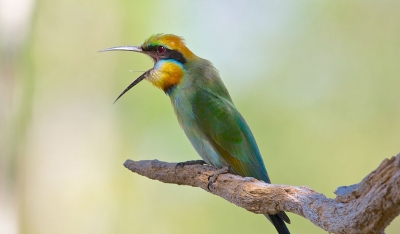How the bee-eater makes its strange nest?

The nests of bee-eaters are strange constructions, like those of the fishing martin. The bee-eater used its long beak to dig out deep tunnels on the steep banks of rivers.
The tunnels open on to a room under the ground, which is the bird’s nest. The floor of the nest is covered in butterflies wings and the remains of insects.
These remains do not make a very comfortable bed but the young bee-eaters seem to like it.
The bee-eater is a tireless flier. From morning until night it goes in search of insects. While other birds help farmers by eating up grubs that live on plants, the bee-eater prefers to catch its victims as they fly along.
The only damage this bird does in hunting is to kill many bees and this angers bee-keepers.
The bee-eater with its brilliant plumage and pointed wings is related to the kingfisher. It is found in Europe and Australia.
Picture Credit : Google







